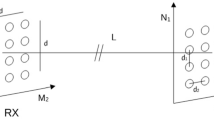Abstract
Spectrally efficient backhaul networks are one of the key-factors for the deployment of next generation wireless cellular systems. The ambitious capacity requirements for future broadband wireless networks and the high infrastructure costs for new cell sites pose new challenges in the design of high capacity point-to-point (PtP) wireless microwave links. In this paper we present a study on PtP links that utilize a peculiar form of multiple-input multiple-output configuration, in which a capacity doubling is obtained by exploiting the geometric characteristics of the Line-of-Sight link. The impact of adaptivity on the maximum achievable transmission distance in presence of the main electronic impairments, for typical physical parameters, is discussed in order to reveal the feasibility and the advantages of this class of solutions.











Similar content being viewed by others
References
Seay, T., & Safavian, S. R. (2008). Next-generation mobile backhaul. Bechtel Telecommunications Technical Journal, 6(1), 1–27.
Giesken, K. (2002). Application of wireless technology in the mobile backhaul network. Bechtel Telecommunications Technical Journal, 1(1), 62–70.
Tipmongkolsilp, O., Zaghloul, S., & Jukan, A. (2011). The evolution of cellular backhaul technologies: Current issues and future trends. IEEE Communications Surveys and Tutorials, 13(1), 97–113.
Mietzner, J., Schober, R., Lampe, L., Gerstacker, W. H., & Hoeher, P. A. (2009). Multiple-antenna techniques for wireless communications—a comprehensive literature survey. IEEE Communications Surveys and Tutorials, 11(2), 87–105.
Liu, L., Wang, H., Yang, G., Zhang, N., Zhao, H., Chang, J., et al. (2007). Characterization of line-of-sight MIMO channel for fixed wireless communications. IEEE Antennas and Wireless Propagation Letters, 6, 36–39.
Driessen, P. F., & Foschini, G. J. (1999). On the capacity formula for multiple input-multiple output wireless channels: A geometric interpretation. IEEE Transactions on Communications, 47(2), 173–176.
Calabrò, S., Lankl, B., & Sebald, G. (2004). Multiple co-polar co-channel point-to-point transmission. AEU International Journal of Electronics and Communications, 58(1), 51–57.
Heath, R. W., Jr., & Paulraj, A. (2005). Switching between diversity and multiplexing in MIMO systems. IEEE Transactions on Communications, 53(6), 962–968.
Mandich, D., Micheli, B., & Mirelli, G. (2006). A theoretical model for dimensioning microwaves point-to-point PDH networks adopting adaptive modulation. Manchester: EuMA.
ITU-R P.530-13. (2009). Propagation data and prediction methods required for the design of terrestrial line-of-sight systems. International Telecommunication Union, Radiocommunication Sector, October 2009.
Acknowledgments
This work was partially supported by SIAE Microelettronica S.p.A., Cologno Monzese (MI), 20093-Italy.
Author information
Authors and Affiliations
Corresponding author
Rights and permissions
About this article
Cite this article
Reggiani, L., Baccetti, B. & Dossi, L. The Role of Adaptivity in MIMO Line-of-Sight Systems for High Capacity Backhauling. Wireless Pers Commun 74, 373–389 (2014). https://doi.org/10.1007/s11277-013-1290-x
Published:
Issue Date:
DOI: https://doi.org/10.1007/s11277-013-1290-x




